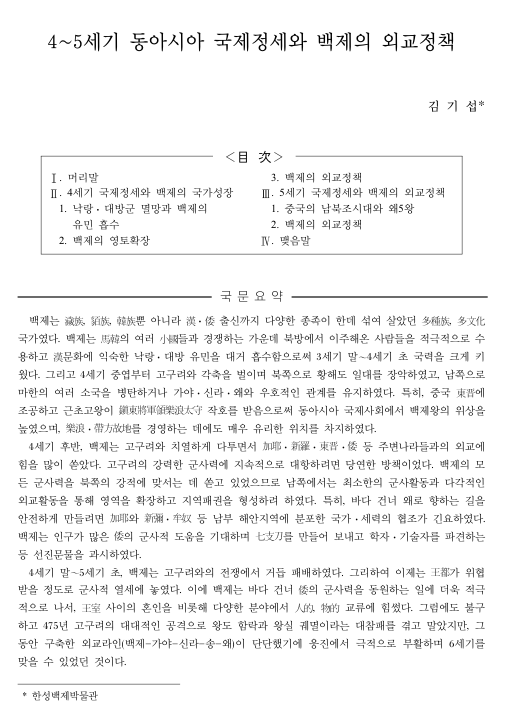김기섭, 2017.2, 4~5세기 동아시아 국제정세와 백제의 외교정책, 백제문화 56권, 공주대학교 백제문화연구소.

Ⅰ. 머리말 Ⅱ. 4세기 국제정세와 백제의 국가성장 Ⅲ. 5세기 국제정세와 백제의 외교정책 Ⅳ. 맺음말 백제는 濊族, 貊族, 韓族뿐 아니라 漢·倭 출신까지 다양한 종족이 한데 섞여 살았던 多種族, 多文化 국가였다. 백제는 馬韓의 여러 小國들과 경쟁하는 가운데 북방에서 이주해온 사람들을 적극적으로 수용하고 漢문화에 익숙한 낙랑·대방 유민을 대거 흡수함으로써 3세기 말~4세기 초 국력을 크게 키웠다. 그리고 4세기 중엽부터 고구려와 각축을 벌이며 북쪽으로 황해도 일대를 장악하였고, 남쪽으로 마한의 여러 소국을 병탄하거나 가야·신라·왜와 우호적인 관계를 유지하였다. 특히, 중국 東晋에 조공하고 근초고왕이 鎭東將軍領樂浪太守 작호를 받음으로써 동아시아 국제사회에서 백제왕의 위상을 높였으며, 樂浪·帶方故地를 경영하는 데에도 매우 유리한 위치를 차지하였다. 4세기 후반, 백제는 고구려와 치열하게 다투면서 加耶·新羅·東晋·倭 등 주변나라들과의 외교에 힘을 많이 쏟았다. 고구려의 강력한 군사력에 지속적으로 대항하려면 당연한 방책이었다. 백제의 모든 군사력을 북쪽의 강적에 맞서는 데 쏟고 있었으므로 남쪽에서는 최소한의 군사활동과 다각적인 외교활동을 통해 영역을 확장하고 지역패권을 형성하려 하였다. 특히, 바다 건너 왜로 향하는 길을 안전하게 만들려면 加耶와 新彌·牟奴 등 남부 해안지역에 분포한 국가·세력의 협조가 긴요하였다. 백제는 인구가 많은 倭의 군사적 도움을 기대하며 七支刀를 만들어 보내고 학자·기술자를 파견하는 등 선진문물을 과시하였다. 4세기 말~5세기 초, 백제는 고구려와의 전쟁에서 거듭 패배하였다. 그리하여 이제는 王都가 위협받을 정도로 군사적 열세에 놓였다. 이에 백제는 바다 건너 倭의 군사력을 동원하는 일에 더욱 적극적으로 나서, 王室 사이의 혼인을 비롯해 다양한 분야에서 人的, 物的 교류에 힘썼다. 그럼에도 불구하고 475년 고구려의 대대적인 공격으로 왕도 함락과 왕실 궤멸이라는 대참패를 겪고 말았지만, 그동안 구축한 외교라인(백제-가야-신라-송-왜)이 단단했기에 웅진에서 극적으로 부활하며 6세기를 맞을 수 있었던 것이다.
Baekje was a multiracial, multi-cultural nation where various ethnic groups such as Yemaek tribe(濊貊族), Han tribe(韓族), Han(漢) and Wae(倭) lived together. From the late third and early fourth centuries, Baekje, while competing with several small countries of Mahan(馬韓), expanded its national power by accepting a large number of immigrants from the north and migrants from Nakrang and Daebang who were familiar with the Han(漢) culture. In the middle of the fourth century, Baekje vied with Goguryeo and took control of Hwanghae-do province to the north, annexed small countries of Mahan and maintained an amicable relationship with Silla, Gaya and Wae to the south. In particular, King Geunchogo enhanced his status in the East Asian countries and stayed ahead of managing Nakrang and Daebang province through paying tribute to the Eastern Jin(東晋) and receiving the title of Jindongjanggun-yeong-Nakrangtaesu(鎭東將軍領樂浪太守; General Stabilizing the East and Governor-Designate of Nakrang) in return. In the late fourth century, Baekje fought fiercely against Goguryeo, and focused heavily on diplomatic relations with neighboring countries such as Silla, Gaya, the Eastern Jin and Wae. It was a natural measure to continue to be proactive against the powerful military strength of Goguryeo. Since Baekje combined all it`s forces against the formidable rival in the north, it sought to expand its territory and create regional hegemony in the south through minimum military action and a wide range of diplomatic activity. Especially, cooperation among the countries next to the southern coastal areas such as Gaya, Silla, and Mono(牟奴) was vital in order to secure the marine route to Wae. Baekje showed off its advanced culture by sending out scholars and engineers and gave the Seven-Branched Sword(七支刀) to Wae in expectation of many soldiers. In the late fourth and early fifth centuries, Baekje was repeatedly beaten in the battle against Goguryeo. Thus, Baekje was in military inferiority so that the capital was threatened. Baekje, therefore, engaged in mobilizing military forces of Wae across the sea, making efforts to promote human and material interchange in various fields like marriage between royal families. Although Baekje suffered a devastating defeat against Goguryeo by the fall of the capital and the destruction of the royal family, it could have been revived dramatically in Ungjin in the sixth century as a result of the strong diplomatic ties amongst Baekje, Gaya, Silla, the Song dynasty and Wae.


의견쓰기
0 개의 의견이 있습니다.